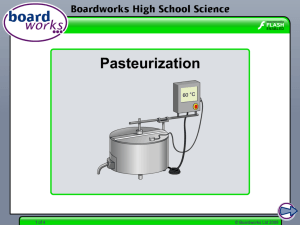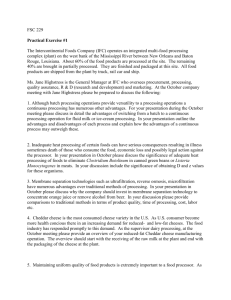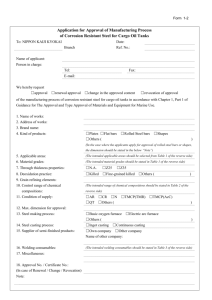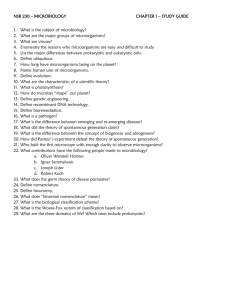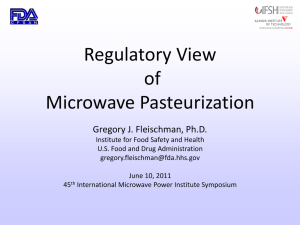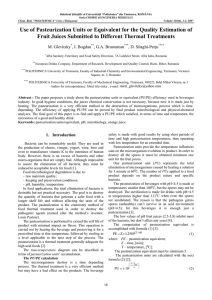2009 Brewing Week 7
advertisement
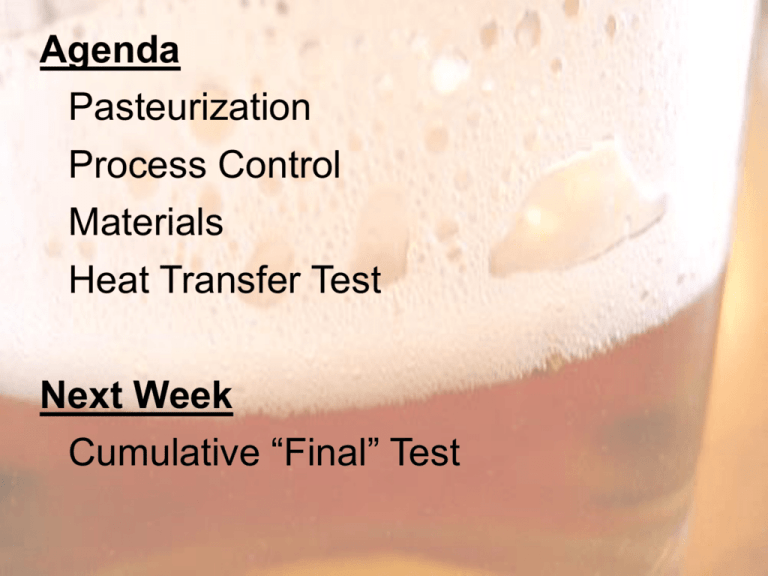
Agenda Pasteurization Process Control Materials Heat Transfer Test Next Week Cumulative “Final” Test Sterile Filtration • Alternative to pasteurization for microbiological stabilization • Avoid heat treatment, flavor deterioration • Occurs before packaging (could be contaminated after filtration, before package) Process Requirements • Feedstock microbiological and non-mb loads (concentration and particle size) • Filtrate concentration, product spoilage concentration allowed • Product viscosity, density, flow characteristics Microbiological Load Reduction – LRV Sterile Filters = 99.9999999999% LRV No. of Organisms at Inlet Titre Reduction No. of Organisms at Outlet Filtration Mechanisms • Direct Interception – Pore smaller than particle • Charge Effects – Particles (-), so filter (+) • Inertial Impactation – Particles want straight path, fluid curves (different densities required) • Diffusional Impactation – Random motion (gas) Key Features Effecting Filter Performance • Pore geometry • Membrane thickness • Surface Charge Removal Ratings • Nominal – “An arbitrary micron value assigned by the filter manufacturer, based upon removal of some percentage of a given size or larger.” • Absolute – “The diameter of the largest hard spherical particle that will pass through the filter under a specified test condition.” Factors effecting flow rate and life: • Pressure Drop • Surface Area P increases as dirt blocks pores Increased surface area has great increase on dirt capacity Surface area can be increased with pleats Filter sizes: • Pre-filter: 1.5 m • Sterile: 0.45 m Cleaning • • • • Backwash (high V) Hot Liquor Sodium Hydroxide Steam Sanitized (120C, 20 min) Pasteurization • Inactivate all microorganisms • Inactivate undesired enzymes (chem. changes) Five Key Factors for Effective Pasteurization • Temperature • Time • Types of microorganisms present • Concentration of microorganisms present • Chemical composition of the product Pasteurization Level • Decimal reduction time, D – Time required to inactivate 90% of microorganisms present • Temperature dependence value, Z – Increase in temp. require to increase D value by 90% Pasteurization Units • Measure of effect of heat and time on microorganisms • 1.0 PU corresponds to 1 minute at 60C • PU = t * 1.393(T-60C) (t in minutes) Rules of Thumb • Increase T by 2C, double PU’s for same time • Increase T by 10C, PU’s increase 10x • 20 PU’s indicates that 1 in 10 Billion microorganisms survive Effect of PU’s on specific microorganisms needed Plate/Flash Pasteurization Typical plates: Stainless steel, 0.6 mm thickness Can withstand 20 bar pressure Design Factors for Plate Pasteurizer • Product Flow Rate and Properties of Liquid • Temperature Program and Pressure Drop • Hygiene and Cleaning Plate Pasteurizer Design • • • • • 95% Heat Recovery in regenerator Product enters Pasteurizer at 4C Holding temperature 72C Holding time 25 seconds Hot water typically used for heating, 2C warmer than holding temperature Level of Regeneration Plate Pasteurizer Control • 0.15C corresponds to 1 PU Flow Control Options • Fixed Flow • Range of Pre-set Flows • Fully Variable Flow Most Suitable Option Depends Upon • Size of Outlet Buffer Tank • Importance of No Recirculation of Product • PU Variation Desired • Product Quality • Type of Filler Minimum Flow typically 1/3 of maximum • Pressure drop 1/9 of max flow (must be adjusted downstream to avoid overpressure) • Heat transfer coefficient decreases, residence time increases Best Practice - Full flow to 1/3 of full in 15 min while maintaining PU’s within 2.0 Control Loops • Holding Cell Temperature • Critical for PU Control • Must be varied with changes in flow • Final Product Outlet • Flow – Upstream and downstream influences • Pressure – Varied with changes in flow Interrelationships of many variables requires use of sophisticated control (PLC) Tunnel Pasteurization Factors Effecting Tunnel Pasteurization • Materials of Construction • Structure and weight – lighter stronger matl • Corrosion – chemical attack metal, cracking • Transport System – typically conveyor • Spray System – Votex or spray pan • Temperature • Heating • PU Control Typical temperature regime Plate/Flash vs. Tunnel Pasteurization • Plate uses significantly less floor space • 15% reduction in operating cost • Reduced capitol costs • Beer tastes fresher (approx 92% less TIU) • Cleaning and contamination downstream Why is Process Control Needed? • • • • • Safety Quality Specifications, Consistency Environmental Regulation, Environmental Impact Optimum Operation of Equipment Cost Effectiveness Aims of Control System • Suppress Influence of External Disturbances • Ensure Stability of a Process Example: External Disturbance on Shower • Flow rate of hot water increases? • Temperature of hot water decreases? • Flow rate of hot water decreases? Stable vs. Unstable Variable • • • • • Goal: Boil Water in an Open Pot at 1 atm Control Variables: Amount of Water, Rate of Heat Given Quantity of Water, Sufficient Heat = Boiling While Boiling: Temp is Stable (or Self-Regulating) Water Level is Un-Stable, Requires Control Pressure Cooker Example • • • • No Pressure Relief – Temp and Press Unstable With Pressure Relief – Temp and Press Stable Level Unstable in Both Weight = Inherent Control Scheme Process Control – A system of measurements and actions within a process intended to insure that the output of the process conforms with pertinent specs Basic Control Elements • Sensor – Receives Stimulus, Outputs Signal • Controller – Receives Signal, Compares to Desired Value, Sends Control Signal • Actuator – Receives Control Signal, Makes Corrective Action on Process • Process – “The Organized Method of Converting Inputs to Outputs Functions of Control System • • • • Measure Compare to Desired Value Compute Error Corrective Action Definitions • • • • Controlled Variable Setpoint Measured Variable Manipulated Variable Example Disturbance? Variables Controlled? Measured? Manipulated? More Accurate More Complicated On/Off Control • Valve Open or Closed, Heater On or Off • Inexpensive and Simple • Oscillatory, Wear on Switching Device Sequence Control • Series of Events (Washing Machine) • CIP Sequence, Fermentation Temperature, Keg Washing and Filling • Achieved with PLC, Pegged Drum (Mechanical) Closed-Loop Control Open-Loop Control • Controlled Variable Measured Prior to Intervention by Manipulated Variable Definitions • Overshoot – Ratio of maximum amount by which response exceeds steady state to final steady state value • Rise Time – Time required for response to reach final value for first time • Response Time – Time it takes for response to settle at its new steady state value Control Example Proportional Control Proportional + Integral Control Proportional + Integral + Derivative Control Feedback vs. Feedforward Control Carbon and Low Alloy Steels • Carbon Steel – Iron alloys with 0.05 to 1% C • Low Carbon Steel – aka mild steel • Low Alloy Steels – alloying elements with <2% Advantages • Inexpensive and readily available • Easily worked and welded • Good tensile strength and ductility Disadvantages • Corrosion • Protective coatings often required Copper • Pure copper traditionally used • Brass – alloyed with zink • Bronze – alloyed with tin Advantages • Soft and easily worked • Readily available for small pipes/tubes • Resists corrosion well • Resistant to caustic and organic acids/salts Disadvantages • Strong acids and oxidizing acids attack • Cost Stainless Steel • Considered stainless if chromium > 11% • Typical values 11-30% chromium • Cr2O3 oxidation layer gives ss it’s passivity General Corrosion • Covers entire surface • “Best” kind of corrosion to have • Measurable and predictable (design for) Galvanic Corrosion • Two metals in contact in same electrolyte • Less noble, less passive, more active metal corroded, other metal protected Erosion and Cavitation • Abrasive particles and/or high velocity • Cavitation corrosion (bubbles near pumps) Sensitisation – Inter-grainal corrosion (415-825C) Pitting – Occurs below surface, chloride ion Localized weak points in passive surface
